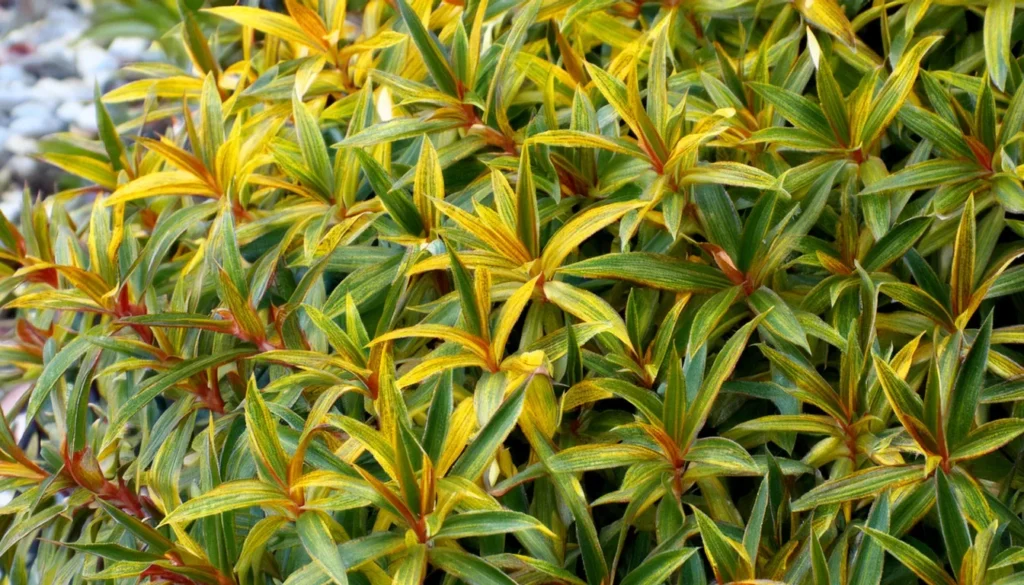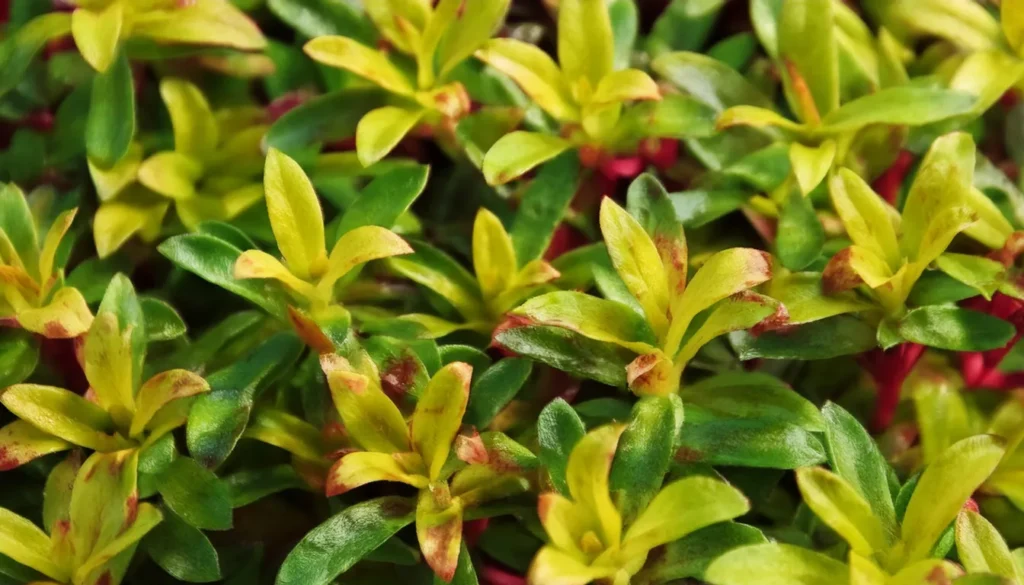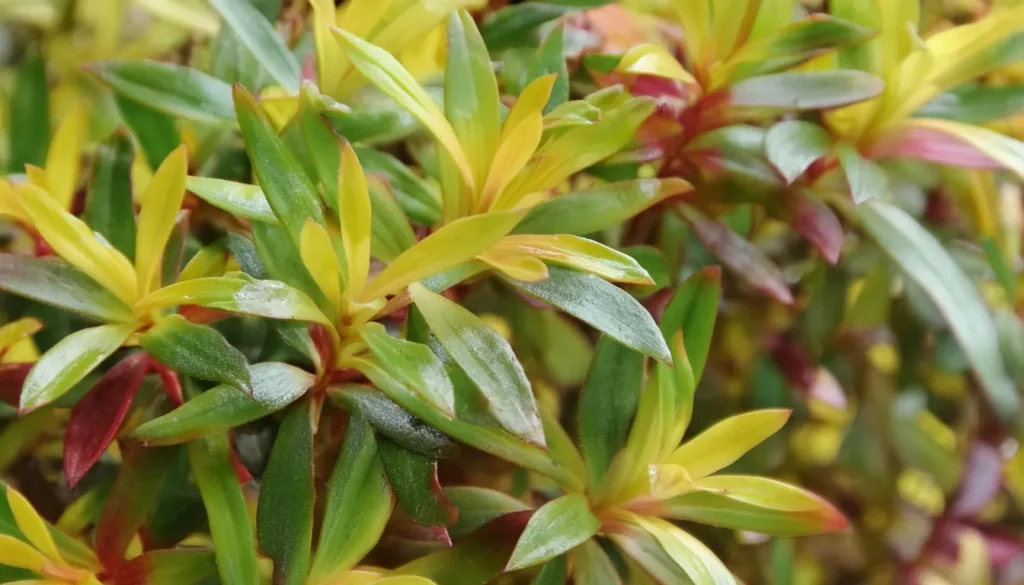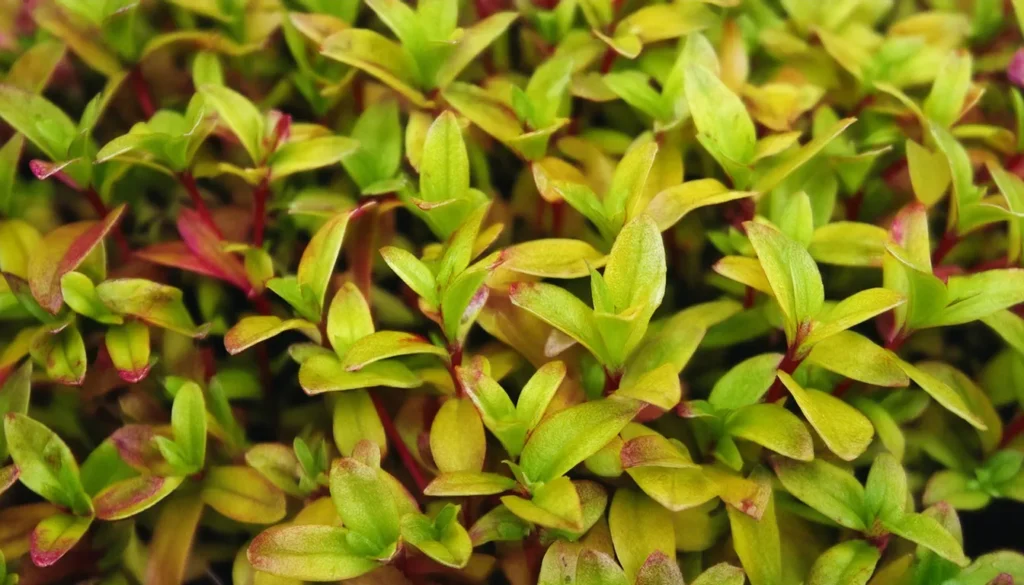Welcome to our comprehensive guide on Nesaea Pedicellata, a captivating aquatic plant that has become a favorite among freshwater aquarium enthusiasts.
Whether you’re a seasoned aquatic gardener or a beginner looking to add a touch of natural beauty to your aquarium, this guide will provide valuable insights and practical tips for cultivating and caring for Nesaea Pedicellata.

As an aquatic plant, Nesaea Pedicellata offers a vibrant and lush addition to your aquarium.
With its striking foliage and unique growth pattern, it adds a touch of tropical elegance to any underwater landscape.
In this guide, we will address everything from the origins and classification of Nesaea Pedicellata to the essential care guidelines and propagation techniques needed to maintain its health and beauty.
Whether you’re looking to create a planted tank setup or enhance an existing aquascape, this guide will provide you with the knowledge and techniques necessary to cultivate Nesaea Pedicellata successfully. Let’s dive in!
Key Takeaway
- Nesaea Pedicellata is a popular aquatic plant known for its vibrant foliage and tropical elegance.
- This comprehensive guide will provide valuable insights and practical tips for cultivating and caring for Nesaea Pedicellata.
- Topics covered include origins and classification, creating the ideal planted tank environment, water parameters, planting techniques, nutrition, pruning and maintenance, propagation, common challenges, aquascaping, and advanced tips for expert aquatic gardeners.
- Follow the cultivation tips and care guidelines in this guide to ensure the successful growth and visual appeal of Nesaea Pedicellata in your aquarium.
Quick Stats
| Attribute | Details |
| Family Name | Lythraceae |
| Origin | West Africa |
| Height | 20-40 cm (8-16 inches) |
| pH Range | 6.0 – 7.5 |
| CO2 Requirement | High |
| Growth Rate | Moderate |
| Care Level | Difficult |
| Color Form | Bright green to golden leaves, with pink to red stems |
| Water Conditions | 22-28°C (72-82°F), soft to moderately hard water |
| Max Size | Can grow up to 40 cm (16 inches) tall |
| Lighting | High |
| Supplements | Requires CO2 supplementation, iron-rich and comprehensive liquid fertilizers for vibrant color and healthy growth |
| Placement | Mid-ground to Background |
| Propagation | Stem cuttings |
What Is Nesaea Pedicellata?
Nesaea Pedicellata, also known as Nelumbo Pedicellata, is a unique species of aquatic plant.
This beautiful plant is native to certain regions and belongs to the family of submerged plants.
It is known for its distinctive characteristics, which set it apart in the world of aquatic plants.
Origins And Classification
Nesaea Pedicellata originates from specific regions and showcases the fascinating diversity of aquatic plant classification.
As a submerged plant, it thrives in aquatic environments, adding a touch of natural beauty to freshwater aquariums and enhancing the overall aesthetic appeal.

Characteristics Of Nesaea Pedicellata
Nesaea Pedicellata exhibits a range of characteristics that make it a captivating addition to any aquarium.
Its morphology is noteworthy, with unique features that contribute to its visual allure. This aquatic plant is recognized for its [insert unique characteristics].
Light Intensity And Spectrums For Optimal Growth
- Lighting plays a critical role in the growth and development of aquatic plants, including Nesaea Pedicellata. Provide your planted tank with appropriate light intensity and spectrums to ensure optimal growth.
- LED lights are highly recommended due to their energy efficiency and ability to provide a wide range of light spectrums suitable for aquatic plant growth.
- The light intensity required by Nesaea Pedicellata may vary depending on its placement within the aquarium.
- If the plant is positioned in the foreground or midground, it will require higher light intensity, typically ranging from 50 to 100 PAR (Photosynthetically Active Radiation). On the other hand, if Nesaea Pedicellata is placed in the background, it can thrive with lower light intensity, usually around 30 to 50 PAR.
Temperature Needs
The temperature needs of Nesaea Pedicellata, commonly known as the Pedicellate Nesaea, typically fall within the range of 72-82°F (22-28°C).
This range mimics its natural habitat conditions and supports robust growth. Maintaining stable temperatures within this range is crucial for ensuring the health and vitality of the plant.
Water Parameters Essential For Nesaea Pedicellata
- pH: Nesaea Pedicellata prefers slightly acidic to neutral water, with a pH range of 6.0 to 7.5. It is important to regularly monitor and adjust the pH levels to ensure optimal conditions for this aquatic plant.
- Temperature: Maintaining the right temperature is crucial for the health of Nesaea Pedicellata. Ideally, the water temperature should be kept between 72°F and 82°F (22°C to 28°C). Fluctuations in temperature can stress the plant and negatively impact its growth.
- Hardness: Nesaea Pedicellata thrives in water with moderate hardness. Aim for a general hardness (GH) level between 4 to 6 dGH and a carbonate hardness (KH) level between 3 to 8 dKH. Keeping the water hardness within these ranges will provide the optimal environment for this aquatic plant.

Substrate Requirements For Healthy Root Development
- Providing a suitable substrate for root development is crucial to ensuring the healthy growth of Nesaea Pedicellata in your planted tank. Choose a fine-grained substrate specifically designed for planted aquariums.
- Opt for substrates that are rich in nutrients, such as clay-based substrates or nutrient-rich soil. These substrates provide essential minerals and organic matter that facilitate the growth of healthy and robust roots in Nesaea Pedicellata.
- Proper substrate depth is also crucial for root development. Aim for a substrate depth of around 2-3 inches to ensure sufficient space for the plant’s roots to spread and establish a strong foundation. This depth allows for optimal nutrient absorption and supports overall plant health.
Placement Option
- Background: Placing Nesaea Pedicellata in the background of the aquarium can create a lush green backdrop that adds depth and visual interest to the tank. It can be planted behind other shorter plants or hardscape elements to provide a natural-looking background.
- Midground: Nesaea Pedicellata can also be positioned in the midground area of the aquarium, where it can serve as a transitional element between the foreground and background. Placing it in this location allows for easy visibility and maintenance while still contributing to the overall aquascape design.
- Foreground: While Nesaea Pedicellata is typically better suited for midground to background positions due to its potential height and growth habit, it can also be used in the foreground with careful trimming and maintenance. Placing it in the foreground adds texture and dimension to the lower areas of the tank.
- Grouping: Consider planting Nesaea Pedicellata in groups or clusters to create visual impact and enhance its natural appearance. Grouping multiple stems together can help create a dense, bushy effect and maximize the plant’s aesthetic appeal.
RELATED: Grow Cryptocoryne Lutea For Vibrant Aquariums With This Simple Guide
Recommended Tank Size
- The recommended tank size for Nesaea Pedicellata, or the Pedicellate Nesaea, largely depends on factors such as the intended aquascape design, available space, and the needs of other aquatic plants and inhabitants. However, as a general guideline:
- For smaller tanks: A tank with a capacity of 10 to 20 gallons can accommodate Nesaea Pedicellata if planted sparsely and with regular trimming to manage its growth.
- For medium-sized tanks: Tanks ranging from 20 to 50 gallons provide ample space for Nesaea Pedicellata to grow and thrive. This size allows for more flexibility in aquascaping and stocking options.
- For larger tanks: Tanks exceeding 50 gallons or more offer plenty of room for Nesaea Pedicellata to spread out and develop into dense, lush stands. Larger tanks also provide opportunities for creative aquascaping layouts and the addition of other plant and fish species.

Suitable Tank Mates
- Peaceful Community Fish: Opt for small, peaceful fish species that won’t disturb the plant or its root system. Examples include tetras, rasboras, danios, and guppies.
- Bottom Dwellers: Consider adding bottom-dwelling fish like Corydoras catfish or small loaches that won’t uproot the plants but will help keep the substrate clean.
- Shrimp and Snails: Invertebrates like cherry shrimp, Amano shrimp, and nerite snails can coexist peacefully with Nesaea Pedicellata while contributing to algae control and substrate maintenance.
- Small Plecos: Some smaller species of plecos, such as bristlenose plecos (Ancistrus sp.), can be suitable tank mates as long as they don’t exhibit destructive behavior.
- Peaceful Dwarf Cichlids: Certain species of dwarf cichlids, such as Apistogramma or German blue rams, can be compatible if kept in small groups and provided with ample hiding spaces.
Understanding Macronutrients And Micronutrients
- In order to thrive, Nesaea Pedicellata relies on a balanced supply of macronutrients and micronutrients. Macronutrients, such as nitrogen (N), phosphorus (P), and potassium (K), are essential for the overall growth and development of aquatic plants. These nutrients are commonly found in aquatic plant fertilizers and can be added to the aquarium water to ensure an adequate supply.
- On the other hand, micronutrients are required in smaller quantities but are equally important for the health of Nesaea Pedicellata. Micronutrients include iron (Fe), manganese (Mn), zinc (Zn), and many others. These elements can be provided through specialized micronutrient fertilizers or through the use of comprehensive fertilizers that contain a wide range of essential nutrients.

Nesaea Pedicellata Cultivation Tips
- Lighting: Provide moderate to high-intensity lighting, preferably with full spectrum LED lights, to support photosynthesis and encourage healthy growth. Aim for 8-10 hours of light per day.
- CO2 Injection: Nesaea Pedicellata benefits from supplemental CO2 injection, which enhances its growth rate and overall health. Maintain CO2 levels within the optimal range of 20-30 ppm.
- Nutrient Supplementation: Regularly dose the aquarium with a comprehensive liquid fertilizer or root tabs to supply essential nutrients like nitrogen, phosphorus, potassium, and micronutrients. Ensure that the nutrient levels are balanced to prevent deficiencies or excesses.
- Water Parameters: Maintain stable water parameters within the following ranges: temperature between 72-82°F (22-28°C), pH slightly acidic to neutral (6.5-7.5), and moderate water hardness (2-15 dGH).
- Substrate: Use a nutrient-rich substrate such as aquasoil or a nutrient-rich gravel to provide Nesaea Pedicellata with essential nutrients for root development and growth.
Plant Propagation Tips
- Select Healthy Stems: Choose stems that are healthy and free from any signs of disease or damage. Look for stems with multiple nodes, as these are where new roots will develop.
- Prepare Cuttings: Using sharp, sterile scissors or pruning shears, cut the selected stems just below a leaf node. Ensure each cutting is at least 3-4 inches in length to provide ample space for root development.
- Remove Lower Leaves: Strip away the lower leaves from the stem cuttings, leaving only a few leaves at the top. This helps reduce the risk of rotting and encourages energy to be directed towards root growth.
- Planting: Plant the stem cuttings into the substrate, ensuring that at least one node is buried in the substrate while leaving the upper portion with leaves exposed above the substrate. You can use planting tweezers to insert the cuttings into the substrate gently.
- Maintain Moisture: Keep the substrate consistently moist to encourage root development. You can mist the cuttings with water or cover the aquarium with a lid to retain humidity.

Benefits Of Planting Nesaea Pedicellata
- Aesthetic Appeal: Nesaea Pedicellata features vibrant red or orange foliage that adds a striking contrast to the greenery in your aquarium. Its colorful leaves can enhance the visual appeal of your aquascape and create a focal point.
- Oxygenation: Like all aquatic plants, Nesaea Pedicellata contributes to oxygenating the water through photosynthesis. This helps maintain optimal oxygen levels for fish and other aquatic inhabitants, promoting their health and well-being.
- Water Filtration: The dense foliage of Nesaea Pedicellata provides surface area for beneficial bacteria to colonize. These bacteria help in the biological filtration process by breaking down organic waste and harmful substances, thus improving water quality.
- Algae Competition: By occupying space and utilizing nutrients in the water column, Nesaea Pedicellata can outcompete algae for resources. This natural competition can help reduce the growth of unwanted algae in the aquarium, leading to a cleaner and healthier environment.
- Habitat Enhancement: This plant can serve as a natural habitat and refuge for small fish, shrimp, and other aquatic organisms. The dense foliage provides hiding spots and shelter, helping to reduce stress and increase overall biodiversity in the aquarium.
CO2 Injection Benefits And Methods
- CO2 supplementation is another crucial aspect of aquatic plant nutrition, particularly for plants like Nesaea Pedicellata, with higher carbon dioxide demands.
- CO2 is essential for photosynthesis, the process through which plants convert light energy into chemical energy to fuel growth. By providing additional CO2, you can enhance the growth and development of Nesaea Pedicellata in your aquarium.
- CO2 injection methods vary, but the most common approaches include using a pressurized CO2 system or a liquid carbon supplement.
- Pressurized CO2 systems involve a CO2 cylinder, regulator, and diffuser to deliver a controlled amount of CO2 into the aquarium water. On the other hand, liquid carbon supplements provide a convenient alternative for those who prefer a non-pressurized method.
Conclusion
After exploring the cultivation tips and care guidelines for this plant, we can conclude that this aquatic plant is truly a stunning addition to any freshwater aquarium.
By following these comprehensive guidelines, you can ensure its successful growth and enhance the visual appeal of your aquascape.
Remember to create the ideal planted tank environment by considering the substrate requirements for healthy root development and providing appropriate light intensity and spectrums.
Additionally, maintaining the correct water parameters, such as pH, temperature, and hardness, is crucial for the health and well-being of Nesaea Pedicellata.
Proper planting techniques and regular maintenance, including pruning and preventing algae growth, are also essential.
Moreover, ensure the plant receives adequate nutrition through fertilization and CO2 supplementation.
With effective propagation techniques and by overcoming common challenges, you can encourage healthy offshoots and control the growth and spread of this plant.
Frequently Asked Questions
How Do I Propagate Nesaea Pedicellata?
Propagating this plant can be done using [insert propagation techniques].
To ensure effective propagation, it is important to consider the timing and troubleshooting tips.
How Do I Maintain And Prune Nesaea Pedicellata?
Regular pruning and maintenance are necessary for the health and aesthetics of Nesaea Pedicellata.
You should [insert maintenance and pruning techniques] to maintain and prune this aquatic plant.
What Are The Common Challenges In Growing Nesaea Pedicellata?
Common challenges in growing the plant include managing algae and bacterial blooms and controlling its growth and spread in aquascapes.
To address these challenges, [insert strategies for challenges in growing Nesaea Pedicellata].
Can Nesaea Pedicellata Be Grown With Companion Plants?
With the right companion plants, this plant can be beautifully showcased in an aquascape.
When choosing companion plants, it is important to consider designing for aesthetic contrast and texture and understanding the synergistic relationships among aquatic plants.
What Are Advanced Tips For Expert Aquatic Gardeners In Growing Nesaea Pedicellata?
For experienced aquatic gardeners, controlling the growth of this plant and creating visually interesting arrangements in the aquascape can be achieved by [insert advanced tips for expert aquatic gardeners].
- Unveiling The Wonders Of Riccia Fluitans In Aquascapes - August 7, 2024
- Vallisneria Gigantea Var. Guide To Care And Cultivation At Home - July 31, 2024
- Vesicularia Dubyana Care & Growth Guide Tips For Beginner Gardeners - July 30, 2024
